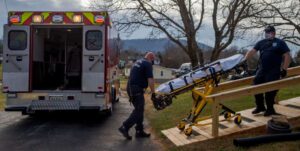by James A. Bacon
Bedford County, an 800-square-mile county in Central Virginia, is theoretically staffed to operate six medic units. Based on call volume, the county could justify maintaining eight units, reports the News & Advance. But on most days one or two of the six are out of service because of insufficient staff to fill them. One day recently, the county had only one paramedic on duty.
The result: longer response times. Delays are potentially a matter of life and death.
The likely root causes of EMT shortages are overwork and insufficient pay, although COVID-related disruptions to training programs have also been a factor in the past year. It is not uncommon for emergency services personnel to work more than 100 hours of overtime a month, sometimes in 72-hour shifts. EMT Jason Morgan says he has not seen a merit increase or cost of living increase since 2004 or 2005. Nationally, shortages are most acute among paramedics, who require more years of education and training.
The chronic teacher shortages in Virginia have gotten considerable media attention, as has the shortage of police officers. It should surprise no one that emergency service personnel are in short supply as well.
There are working conditions unique to each profession that discourage people from making a career of teaching, police and rescue. Teachers are asked to do double duty as teachers and social counselors. Police face the contempt of large segments of the population. Fire and rescue workers face no such problems. Everyone loves them. The problem, I suspect, is that they’re taken for granted.
What we’re seeing in Virginia reflects larger national and economic trends. Over the past three to four decades, working people have not shared proportionately in the rewards of economic growth and prosperity. The upper and professional classes have enjoyed significant income gains, while poor people have benefited from a steady expansion of the welfare state. Teachers, police and EMT workers, by contrast, have seen their compensation barely keep pace with the cost of living, especially in major metropolitan areas where housing prices have increased far more rapidly than compensation. Now with inflation running at 6.8%, most working people are losing ground.
Broadly speaking, local governments can do two things to hang on to these essential workers. First, they can improve working conditions, mainly by treating these workers with more respect. People don’t work just for the money — they seek dignity and recognition for their contributions. Dial down the anti-police rhetoric. Stop second-guessing teachers. Let both do their jobs.
Good luck with that. Local governments have little power to reverse unrealistic parental expectations of teachers or the radical social movements that de-legitimize police.
The other thing local governments can do is pay more.
Higher pay seems to be in the cards for teachers in the next biennial budget. Governor Ralph Northam has proposed increasing teacher pay by 10 percent over the next two years. There’s been talk of paying police more, too. I haven’t heard much sympathy expressed for the plight of fire and rescue workers. If the News & Advance article is an indication, though, that might be changing.
In an ideal world, local governments would find ways to offset the cost of paying teachers, police and EMTs more by paring less essential services and pruning non-essential workforce. Good luck with that, too. If we like having enough teachers in schools, police on the streets, and fire & rescue teams on call, tax-paying citizens will have to grit their teeth and pay them more.



